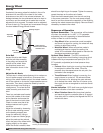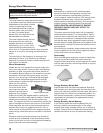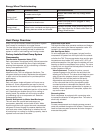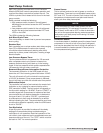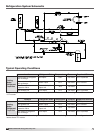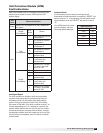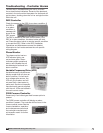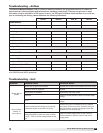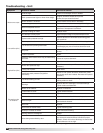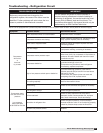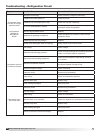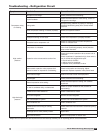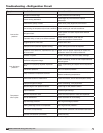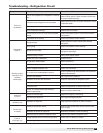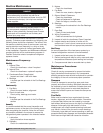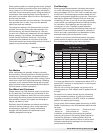
30
Model ERCH-HP Energy Recovery Unit
Troubleshooting – Unit
Symptom Possible Cause Corrective Action
Motor over amps
CFM too high. Check cfm and adjust drives if needed.
Static pressures are higher or lower than design.
If higher, ductwork should be improved.
If lower, fan rpm should be lower.
Blower rotation is incorrect. Check rotation and reverse if necessary.
Motor voltage incorrect. Check motor nameplate versus supplied voltage.
Motor horsepower too low.
See specifications and catalog for fan curves to
determine if horsepower is sufficient.
Shorted windings in motor. Replace motor.
Low airflow (cfm)
Unit damper not fully open. Adjust damper linkage or replace damper motor.
System static pressure too high.
Improve ductwork to eliminate losses using good
duct practices.
Blower speed too low. Check for correct drives and rpm with catalog data.
Fan wheels are operating backwards.
For 3-phase, direction can be reversed by
interchanging any two of the three electrical leads.
Dirty filter.
Follow cleaning procedures in Routine Maintenance
section.
Leaks in ductwork. Repair.
Elbows or other obstructions may be obstructing
fan outlet.
Correct or improve ductwork.
Belt slippage. Adjust belt tension.
High airflow (cfm)
Blower fan speed too high.
Check for correct fan rpm. Decrease fan speed if
necessary.
Filter(s) not in place. Install filters.
Insufficient static pressure (Ps) (airflow
resistance).
Induce Ps into system ductwork. Make sure grilles
and access doors are installed. Decrease fan speed if
necessary.
Excessive noise
or vibration
Fan wheel rubbing on inlet.
Adjust wheel and/or inlet cone. Tighten wheel hub or
bearing collars on shaft.
Bearings.
Replace defective bearing(s). Lubricate bearings.
Tighten collars and fasteners.
Wheel out of balance. Replace or rebalance.
Loose wheel on shaft. Tighten wheel setscrew.
Loose motor or blower sheave. Tighten sheave setscrew.
Belts too loose. Adjust belt tension after 24 hours of operation.
Belts too tight.
Loosen to maintain a 3/8 inch deflection per foot of
span between sheaves.
Worn belt. Replace.
Motor base or blower loose. Tighten mounting bolts.
Buildup of material on wheel. Clean wheel and housing.
Bearing and drive misaligned. Realign.
Noise being transmitted by duct.
Make sure ductwork is supported properly. Make
sure ductwork metal thickness is sized for proper
stiffness. Check duct size at discharge to ensure that
air velocities are not too high.
Always have a completed Pre Start-Up Checklist and Unit Start-Up Checklist prior to requesting parts or service information.



